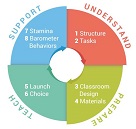Gail Boushey
If students are stressed out, information cannot get in. This is a matter of science.
—Judy Willis, MD

- Gail in first grade -
I remember being in first grade. Sitting in the last seat of the last row, I memorized the back of the head in front of me. The room had a chill about it. It was pin-drop silent, except for the occasional announcement in a voice that reminded me of Charlie Brown’s teacher: “Waaa, waaa, waaa, waaaa . . .”
This image is burned into my memory. I didn’t like school, which was starkly different from the joyful home I would leave each morning. The contrast created disequilibrium, stress, and anxiety that I didn’t know how to navigate. I found it challenging to focus on reading when I wasn’t comfortable in my surroundings.
I have spent years—you might even say my whole life—researching and observing the effect of classroom environments on children and the teachers who create those environments. I have often wondered how different my own school years would have been if my teachers had welcomed us at the door. What if my classroom environment had included reading with other students, working in cozy areas filled with pillows and rugs, a happy hum of music and quiet talk, and friendships?
Thankfully we know more now than when I started school. Thanks to brain research, we know that students’ comfort level has a profound influence on their brains’ ability to process and retain information. When teachers use strategies to reduce stress and build a positive emotional and physical environment, students gain emotional resilience. They learn more efficiently and at higher levels of cognition.
What can you do to create such an environment?
1. Take care of yourself. Replenish, reinvigorate, be happy, and rejoice in who you are as a teacher. Remind yourself that you are the best you there is!
2. Create joy in your life and exude that joy to others. Joy and enthusiasm are absolutely essential for learning to take place in adults and children. See the joy that is all around us—and if you don’t see it, create it for yourself and others. Carry joy with you always.
3. Bring joy into your classroom through words and actions. Enjoy the beautiful learning environment you have created—from the smiles with which you greet your students to your one-on-one conferring to celebrate each student’s progress toward becoming the very best they can be.
4. Create a classroom in which all students can find comfort and joy, all day and every day of the entire school year.
We are responsible for creating environments in our rooms that allow and encourage students to thrive and excel. We can and should invite them into environments that help them reach their full potential while immersed in joy.
Back to School
Back-to-school online seminar is available today through September 21.
See your email invitation for details.
News from The Daily CAFE
 Essential Elements Are Here! . . .
Essential Elements Are Here! . . .
Elements of CAFE
This invaluable tool will help you assess your knowledge and application of CAFE, leading to thoughtful reflection and meaningful goal-setting.
 A Great Idea . . .
A Great Idea . . .
Making Ourselves Proud*
This is easy to set up and will help promote positivity and continued learning when you are absent.

Daily 5 . . .
Remembrance of a Reader
Janice Such wants us to know about a special student named Joe.
 Focus on Health . . .
Focus on Health . . .
A Hive of Curiosity
One of Carol's goals is to never curb the curiosity of a busy hive.




